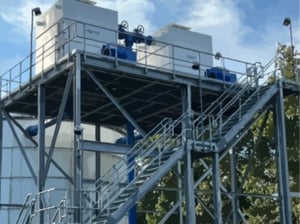Maximizing Efficiency and Flow: Industrial Water Treatment with Degasification Systems
 Industrial water treatment plays a critical role in maintaining water quality and ensuring the efficient operation of various processes. Degasification and decarbonation systems are essential components of such treatment methods. These systems effectively remove gases from the water, improving its quality and minimizing the risk of corrosion. However, when designing and installing degasification or decarbonation towers, it is important to consider hydraulic flow and system design. This blog post will explore the significance of proper hydraulic fundamentals in optimizing degasification systems, avoiding common pitfalls, and ensuring smooth water flow.
Industrial water treatment plays a critical role in maintaining water quality and ensuring the efficient operation of various processes. Degasification and decarbonation systems are essential components of such treatment methods. These systems effectively remove gases from the water, improving its quality and minimizing the risk of corrosion. However, when designing and installing degasification or decarbonation towers, it is important to consider hydraulic flow and system design. This blog post will explore the significance of proper hydraulic fundamentals in optimizing degasification systems, avoiding common pitfalls, and ensuring smooth water flow.
Optimizing Hydraulic Flow for Degasification Systems
However, applying sound hydraulic principles during the system design phase is crucial to prevent costly issues. Design professionals typically consider factors such as the size of the effluent fitting or pipe diameter and base their design on the length of the run and elevation. Failing to account for these factors can lead to hydraulic turbulence and improper water flow.
Preventing Tower Flooding and Hydraulic TurbulenceIn addition, incorporating vacuum relief valves is often necessary to allow air to enter the pipe, maintaining flow balance and preventing disruptions. These practical solutions may not be found in standard engineering handbooks but are essential for optimizing the performance of degasification systems.
Industrial water treatment systems rely on the effective removal of gases through degasification and decarbonation. To ensure optimal performance, it is vital to consider hydraulic flow and system design when installing degasification towers. Proper placement, utilization of elevation, and the integration of vortex breakers and vacuum relief valves are key considerations. By implementing these hydraulic fundamentals, industries can avoid costly pitfalls and maximize the efficiency and longevity of their industrial water treatment systems. For more information or to consult with the professionals at DeLoach Industries Inc., contact them at (941) 371-4995.
Receive Your Free Odor Control E-Book
Related Blog: Avoiding Hydraulic Air Locks in a Degasification Tower





